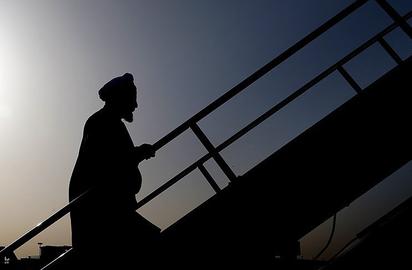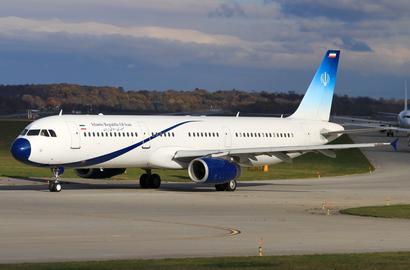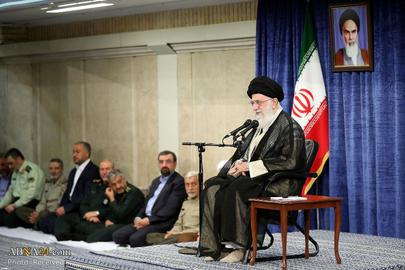On May 24, the US Department of Treasury put Dena Airways on its terrorism sanctions list, based on a 2001 presidential order designed "to impede terrorist funding.” Dena Airways operates only one aircraft, a 19-year-old Airbus A340-300, used by the President of the Islamic Republic. So in other words, the US has indirectly targeted President Hasan Rouhani with its anti-terrorist sanctions.
The US Treasury announcement warns “those who grant landing rights and provide general services to these aircraft...could be exposed to US sanctions.”
It goes without saying that aircrafts always need a myriad indispensable services on the ground in the airport — from fueling, engineering safety inspections, spare parts, tow trucks and hangars to other services for the crew and the passengers. Generally these services are provided by private companies that are much more vulnerable to sanctions than the governments.
Considering all of this, the president of the Islamic Republic must find a way to bypass or, as Iranian officials put it, “go around,” US sanctions. In the coming weeks Rouhani is scheduled to pay visits to China, Austria and Switzerland. In the last five years he has also traveled to New York to attend the annual UN General Assembly sessions. Now that Dena Airlines is on the US sanctions list how can the Iranian president continue with his international visits?
One Flight, One New Airline
The simplest solution is to replace Dena Airlines with another airline to operate the plane. The US has already put sanctions on a number of Iranian airlines, including Mahan Air, Caspian Air, Meraj Air, and Pouya Air. So Iranian officials would have to form a new company to operate the president’s VIP plane. But of course the US can easily apply sanctions to the new company as well, as it did with Meraj Air, which previously operated the plane. After Meraj Air was put under sanctions, officials set up Dena Air. The company is so new that it does not even have an official logo — but the Americans quickly found out about it and added it to their list.
So creating a new company is not going to work, unless, perhaps, every time that President Rouhani travels abroad, the plane is re-registered under the name of another newly-created company.
Would the US Make an Exception?
The second solution, however, is to ask the US to make an exception for the company. In the years that nuclear-related sanctions were imposed on Iran, officials facing sanctions requested exemptions on a case-by-case basis. One example was Ali Akbar Salehi, the current head of Iran’s Atomic Energy Organization, who in 2011 was confirmed as foreign minister by the parliament and hoped to pay an official visit to several European countries.
High-level officials of all countries enjoy immunities that make it difficult to enforce sanctions against them. But here, instead of applying sanctions to the Iranian presidential plane itself — something that would have been unpopular with other countries and would have been likely to be ignored — the US decided to place sanctions on the operating company. This is what Americans call “intelligent sanctions.”
Dena Air was created to operate one plane, and one plane only, serving the Iranian president after Meraj Air was put on the sanctions list. This company has no other plane to carry arms or otherwise engage in activities in support of terrorism and it is inconceivable that the official plane of the Iranian president would carry arms, either. So the only possible conclusion is that the US’ main goal in placing sanctions on Dena Air — and not the plane itself — was to prevent Iranians “going around” sanctions. As a result, it does not seem that asking for an exemption for Dena Air would have a chance of success, and that was why Iranian officials did not seek to remove the sanction on Meraj Air either.
In 2017, during one of Iranian Foreign Minister Mohammad Javad Zarif’s visits to Germany, the companies that had been responsible for refueling the plane refused to do so. Such an incident can damage the image and the dignity of the Iranian president. And some believe that this is exactly what the US is aiming for. "So what's Trump's aim?” wrote Trita Parsi, executive director of the National Iranian American Council (NIAC). “Humiliate Iran's moderates and strengthen its hardliners."
Let the Host Government do it
A third solution is to ask the host government to provide necessary services for the president’s official plane. This must be done when the president of the Islamic Republic draws up detailed plans for an official visit in coordination with the host country.
Zarif’s plane was denied refueling because it was registered under the name of Meraj Air, which was already on the sanctions list. In the end, the German government was forced to dispatch its military fuel tankers to refuel the foreign minister’s plane. Entities that belong to the state do not fall under American sanctions but, again, such a solution is not good for the image of the president.
Rent a Plane
The fourth solution to counter the sanctions on companies that operate the president’s plane is to rent a plane from domestic airlines that are not under sanctions, or from foreign carriers. By custom, the plane carrying the Iranian president displays the logos of the President of the Islamic Republic and of the Iranian carrier as symbols of national sovereignty. Not many planes that belong to domestic airliners can be used as VIP planes and, besides, if they agree to rent out their planes to be used by the president they are in danger of being put under sanctions as Meraj Air and Dena Air were — and in which case they would lose the ability to resume their normal flights to foreign countries. Rented airliners from foreign companies would not only be bereft of national Iranian symbols, they do not help the prestige of high-level officials either.
Even if the the first three solutions, with all their shortcomings, solve the problem of Rouhani’s visits to Asian and European countries, they would not solve the problem of his visit to New York and the United Nations. The sanctions are imposed by the United States, so it is unlikely that US Treasury’s sanctions can by bypassed on American soil or that the American government would agree to make an exception to its “intelligent sanctions.”
So only two choices for traveling to New York remain. Either Iran must register a new company to operate the plane just before the president flies and before the US has a chance to sanction the new company, or the Iranian government must resort to the fourth solution — renting foreign planes — to make it possible for the chief executive of the Islamic Republic to attend the key UN meetings.
More on the aftermath of Trump’s withdrawal from the nuclear treaty with Iran:
The Nuclear Deal: Will Khamenei Get What he Wants?, May 29, 2018
Khamenei’s Eight Conditions for Talks with Europe, May 25, 2018
Revolutionary Guards Respond to Pompeo’s “Empty Bluff”, May 23, 2018
The 12 Demands of Pompeo's New Iran Strategy, May 21, 2018
When Will US Sanctions Hit Iranian Oil Sales?, May 18, 2018
The JCPOA: A Missed Opportunity, May 17, 2018
The Future of Iran’s Economy as the US Bows Out of the Deal, May 10, 2018
What are Iran’s Choices as US Abandons the Nuclear Deal?, May 9, 2018
Khamenei’s “Heroic Flexibility 2.0”, May 9, 2018
What you Need to Know About Trump and the Nuclear Deal, May 8, 2018


























comments